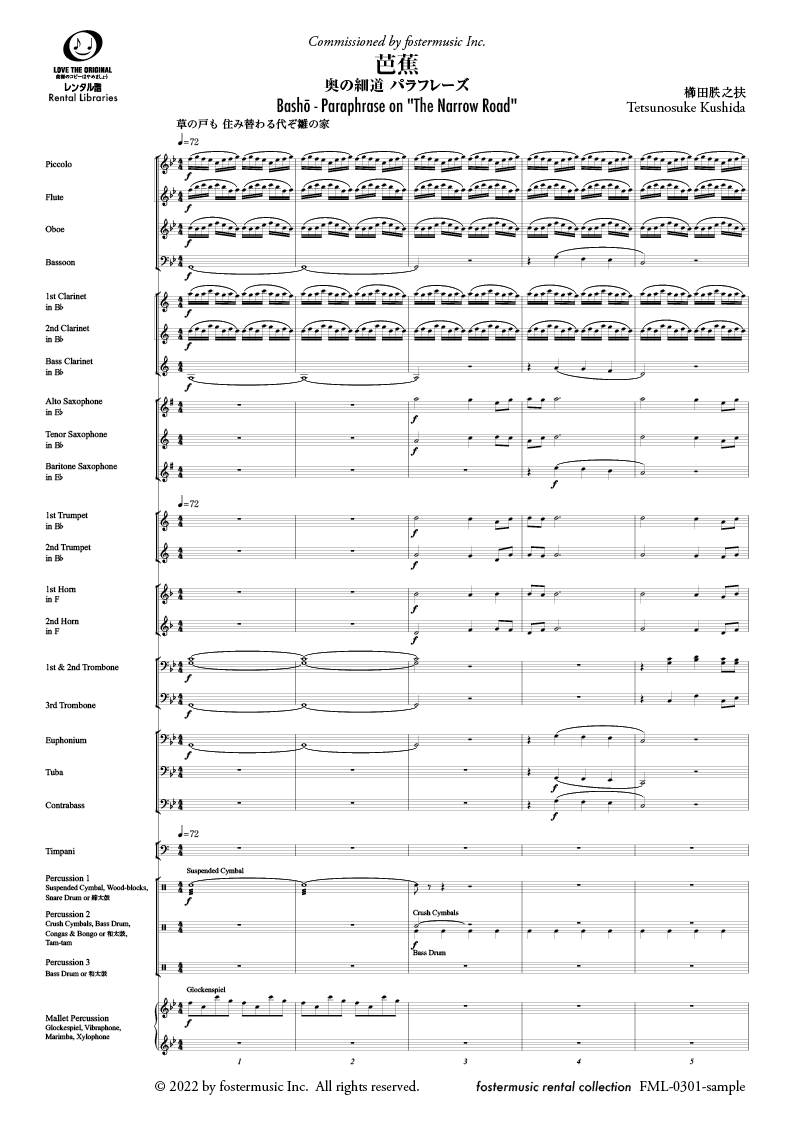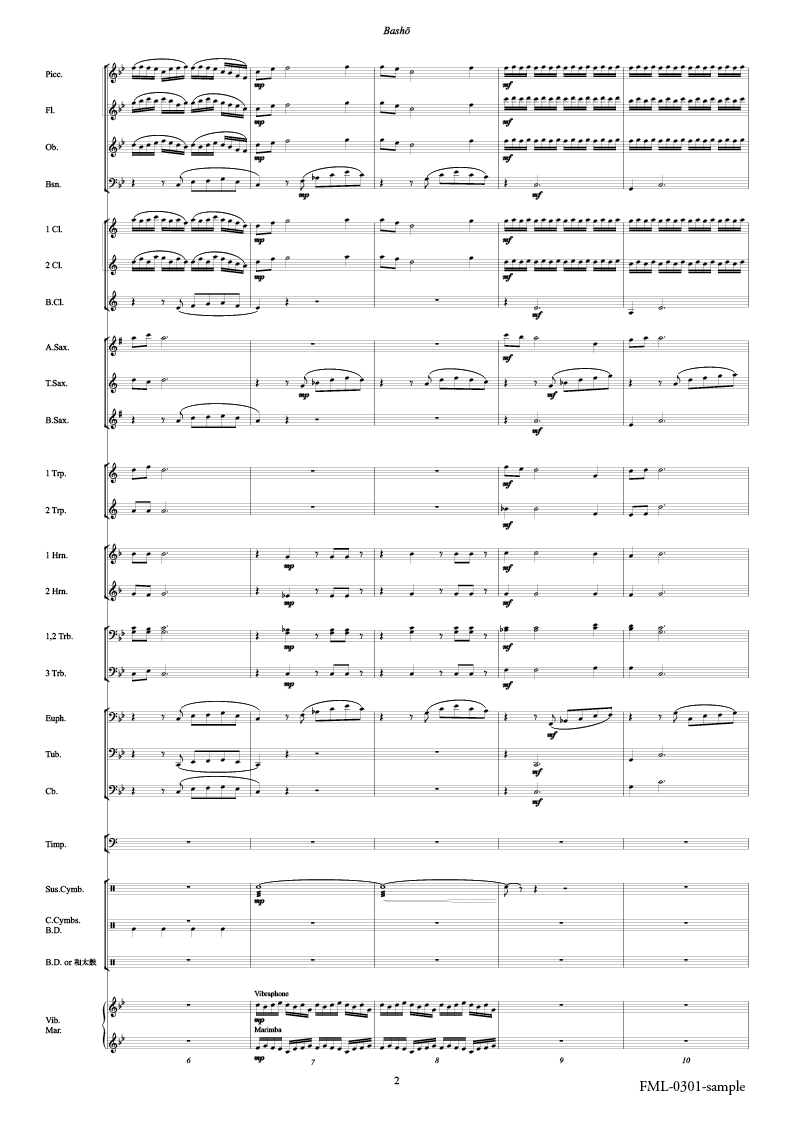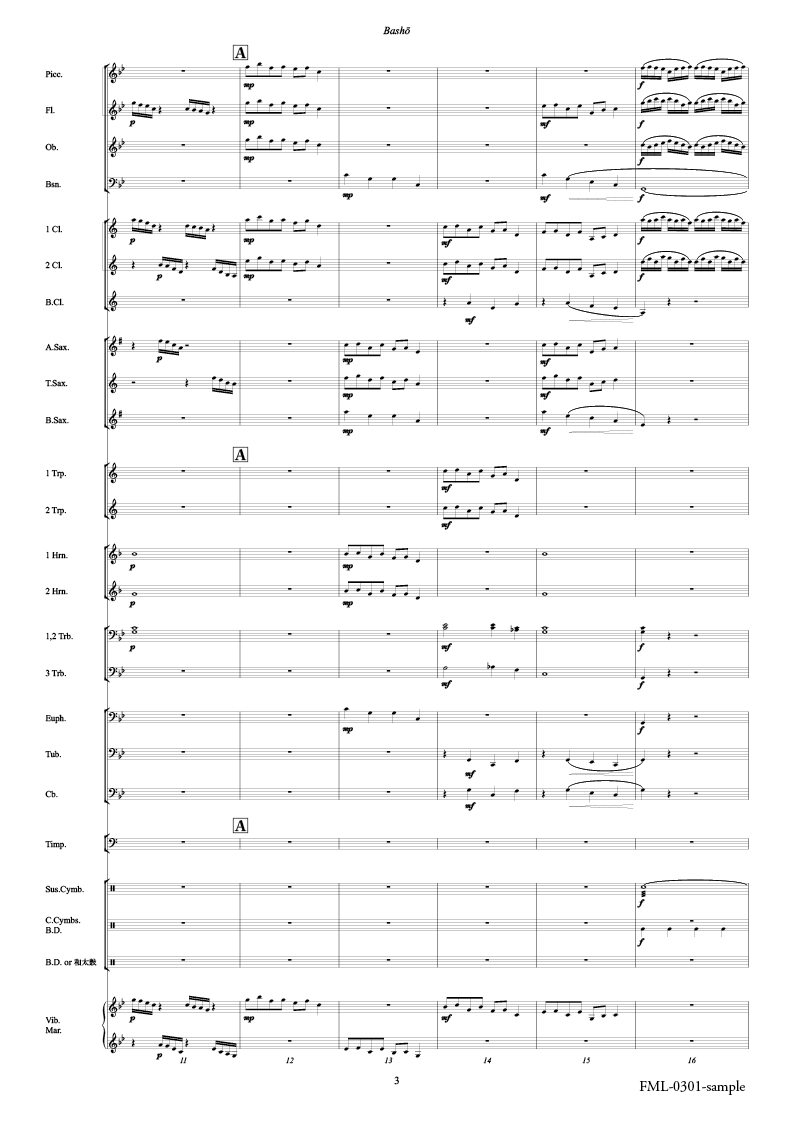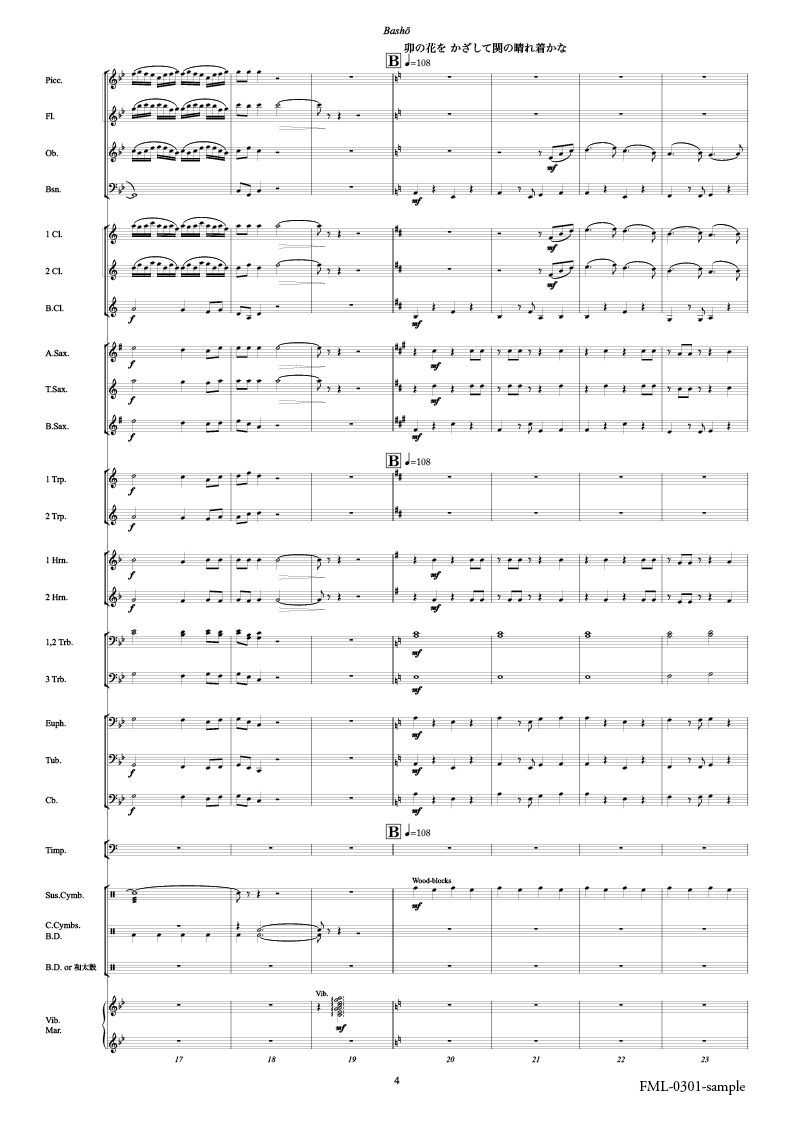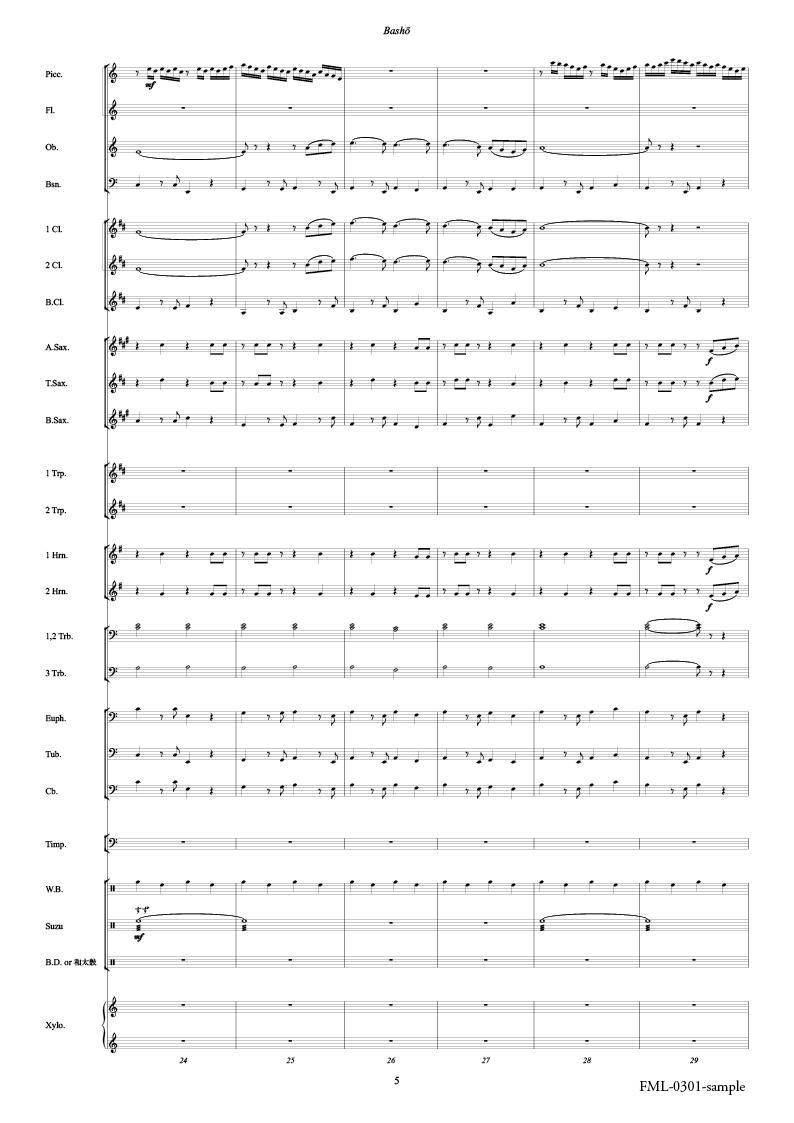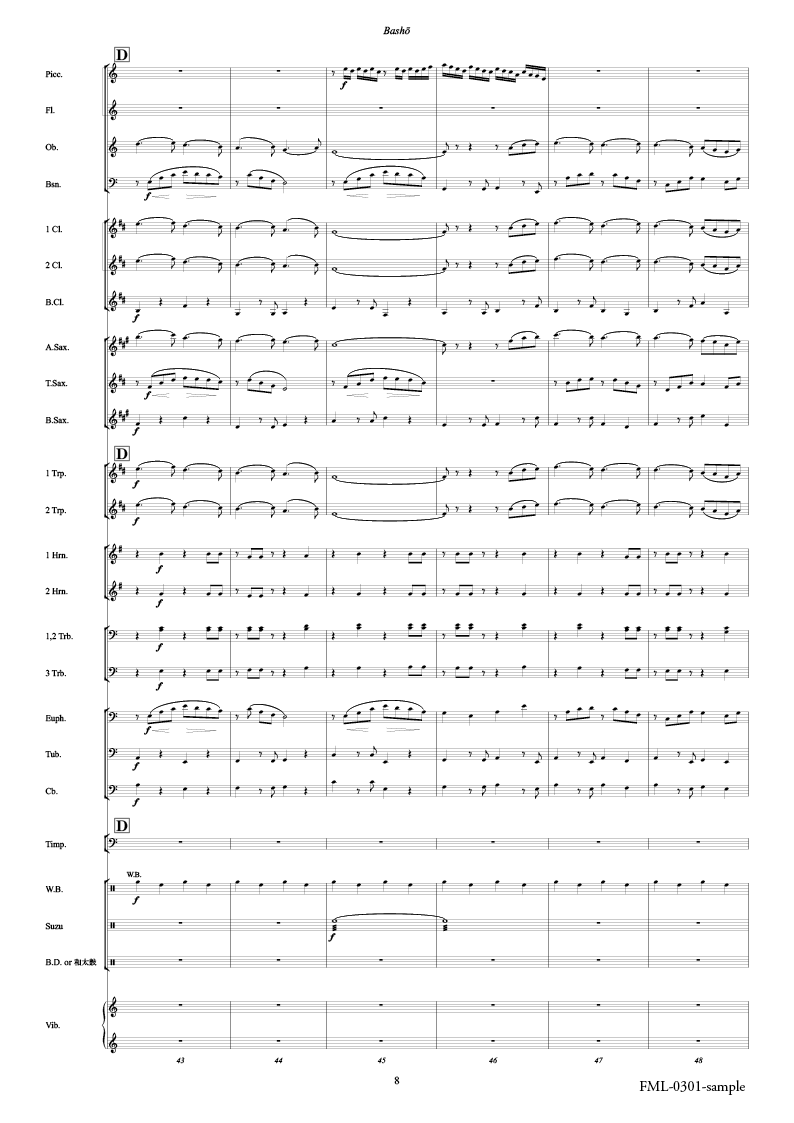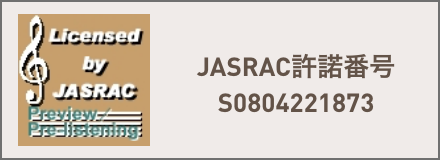12月25日15時を持ちまして、
2025年内出荷の注文受付を終了いたしました。
以降のご注文は年明け
【 2026年1月7日(水)以降順次出荷 】
となります。予めご了承ください。
本年もたくさんのご愛顧を賜りありがとうございました。
よいお年をお迎えください。
芭蕉~奥の細道 パラフレーズ:櫛田てつ之扶 [吹奏楽中編成-レンタル譜]
・1配送につき税込11,000円以上のご注文で国内送料無料
・コンビニ後払い、クレジットカード、銀行振込利用可
・[在庫あり]は営業日正午までのご注文で即日出荷
・International Shipping
- 作曲: 櫛田てつ之扶
- 編成:26パート
- 演奏時間:0:08:10
- グレード:3+
フォスターミュージック/FML-0301
- 概要
- 編成/曲目
- 補足
- ENGLISH
芭蕉~奥の細道 パラフレーズ
【楽曲解説】
俳人・松尾芭蕉の紀行文集「奥の細道」に添ったパラフレーズです。「奥の細道」の俳句の印象を、音による映像として作曲しました。
取り上げた句に対しては、そのイメージを絵画的にとらえています。俳諧としても自己の境地における、かなり自由な印象を楽しんでいます。その意味で気紛れなパラフレーズと、呼ぶことが出来ます。
紀行文の順に従って、5句取り上げました。俳句の17文字を何音のフレーズにするか、枯淡閑寂の境地を、音楽の語法で描くという、困難でもあるし大いに楽みでもありました。和魂洋才の滲み出る作品になっています。
【演奏に際して】
「草の戸も 住み替わる代ぞ 雛の家」日々旅にして旅をすみかとするという決意を、柱にかがげて家を出る、旅立ちの心を豊かに表現します。太いラインのコラールで、フレーズは息を長く取ります。
「卯の花を かざして関の 晴れ着かな」心もとない日を重ねながら、白河の関まで来た、気 持ちも幾分晴れたという。道中を行き来する様子を描いています。幾分早足で行き交う人々を、軽快なテンポで旋律を表現します。
「松島や 鶴に身を借れ ほととぎす」一人旅寝をうつらうつらしながら、物思いに耽る。TromboneのソロはゆったりとTempo rubatoして、静かに歌います。情感の漂う楽節に創りあげます。
「夏草や つはものどもの 夢の跡」藤原三代の栄華の跡、山河のみ残されている、その寂しさに涙する。冒頭から闘いの場を表現します。力強く・歯切れよく、旋律を積み重ねて行きます。打楽器群は、多くの打楽器を組み合わせて、バンド独自の色彩を創ります。ラテン打楽器と和太鼓とのコラボは、独特の響きを創り出すことが出来ます。最後のTimpaniのソロは、武将の最後の場面として激しく演奏します。
そのあと、夏草・夢の跡と静かに終わり、最後「荒海や 佐渡に横たふ 天の河」の雄大なコラールへ移ります。Piccolo・Flute・Vibraphone・Marimbaは、冴える星のきらきらとした光です。越後・出雲崎から、泡波を隔てて横たわる佐渡が島を見渡し、半天にかかる銀河の鮮やかさを描きます。コーダは、沖から寄せて来る荒波です。音による俳句を創作して下さい。(櫛田てつ之扶)
仕様
- アーティスト
- 作曲: 櫛田てつ之扶
- 演奏形態
- 吹奏楽
- 編成
- 中編成 / 26パート
- 演奏時間
- 0:08:10
- グレード
- 3+
- 主要ソロ
- Trombone, Trumpet, Alto Saxophone
- 商品形態
- レンタル譜(Full Score & Part)/レンタル楽譜ご利用案内
- 出版社 / 品番
- フォスターミュージック / FML-0301
- 発売日(年)
- 2022/01/27
- キーワード
- オリジナル, 和風,
- 【スコア】芭蕉~奥の細道 パラフレーズ:櫛田てつ之扶 [吹奏楽スコア]
スタディスコア/セット・版違いなど
楽器編成
- 主要ソロ:Trombone, Trumpet, Alto Saxophone
- Full Score
- Piccolo
- Flute
- Oboe
- Bassoon
- Bb Clarinet 1
- Bb Clarinet 2
- Bass Clarinet
- Alto Saxophone
- Tenor Saxophone
- Baritone Saxophone
- Trumpet 1
- Trumpet 2
- Horn 1
- Horn 2
- Trombone 1
- Trombone 2
- Trombone 3
- Euphonium
- Tuba
- String Bass
- Timpani
- Percussion 1 (Sus.Cymbal, Wood-block, S.D. or 締太 )
- Percussion 2 (C.Cymbal, B.D., Congas & Bongo or 和太 , Tam-tam)
- Percussion 3 (B.D. or 和太 )
- Mallet Percussion
- (Glock., Vib., Mari., Xylo.)
- サイズ
- A4/3cm未満
BASHO - PARAPHRASE ON "THE NARROW ROAD":Composer: Tetsunosuke KUSHIDA
This is a paraphrase of the travelogue "The Narrow Road" by the haiku poet Matsuo Basho. I have written this piece as an acoustic rendition of my impressions of five haiku poems in their original order that seeks to capture their imagery in a pictorial way.
My capricious paraphrase of the poems as a haikai was also my way of freely indulging in impressions that had formed in my own mind.
It was both a challenge and a source of great pleasure for me to figure out the number of notes that I should use in a musical phrase to capture a haiku with 17 syllables and how I could depict the state of mental tranquility using the language of music. The result is a work that fuses the Japanese spirit with Western learning. I look forward to your interpretation of haiku poetry through music.
Opening:
The opening portrays the narrator's determination to make every day a journey and the journey itself his home, while also giving voice to the narrator's state of mind as he takes the plunge and leaves home to begin his journey. The thick tone of the chorale is the result of musical phrases that require drawing in a deeper breath.
B:
After several anxious days, the traveler reaches the Shirakawa Barrier, which lifts his spirits somewhat. This section depicts the traveler on the road, and the melody here has a quick tempo that captures the brisk footsteps of passersby.
E:
The lone traveler falls into a pensive state of mind as he starts to doze off. The trombone performs a slow, subdued solo in tempo rubato that contains passages with powerful emotions.
H:
Only the mountains and rivers survive from the glorious days of three Fujiwara generations, and the loneliness brings a tear to the eye. This section opens with scenes of battle, and the melody builds up powerfully and decisively. The percussion section combines its many instruments to bring forth the band's unique tone here, with the combination of Latin percussion instruments and Japanese taiko drums creating a distinctive sound. The closing timpani solo unfolds intensely, symbolizing the final moments of the warlords.
L:
The final section features a majestic chorale, where the piccolo, flute, vibraphone, and marimba combine to depict the shining light of brilliant stars. The music evokes vibrant images of galaxies suspended in the night sky of Izumozaki, Echigo, from which Sado Island can be seen across the rolling waves. The piece closes with a Coda that portrays rough waves crashing against the shore.
Specifications
- ARTIST
- Composer: Tetsunosuke KUSHIDA
- INSTRUMENTATION
- Windband / 26-35 players
- DURATION
- 0:08:10
- GRADE
- 3+
- PRODUCT TYPE
- Set / RENTAL (Full Score & Part)
- PUBLISHER / Code
- fostermusic Inc. / FML-0301
- RELEASE
- 2022/01/27
- OVERSEAS SHIPMENT
- Yes
- EUROPEAN PARTS
- Not Included

![芭蕉~奥の細道 パラフレーズ:櫛田てつ之扶 [吹奏楽中編成-レンタル譜]](/html/upload/save_image/FML0301_1.png)

